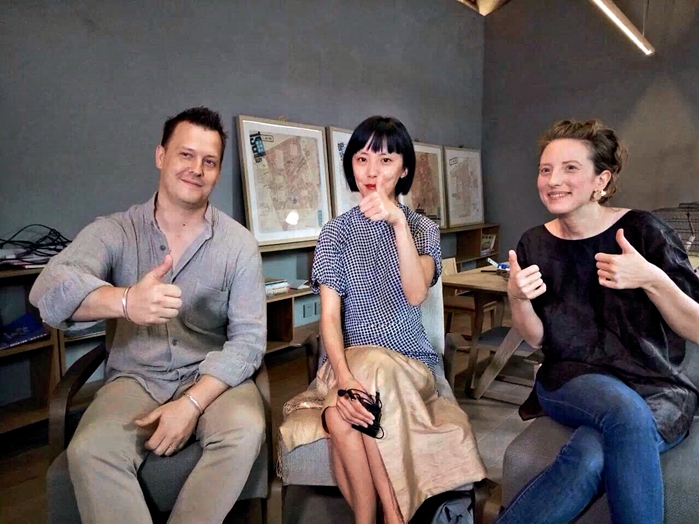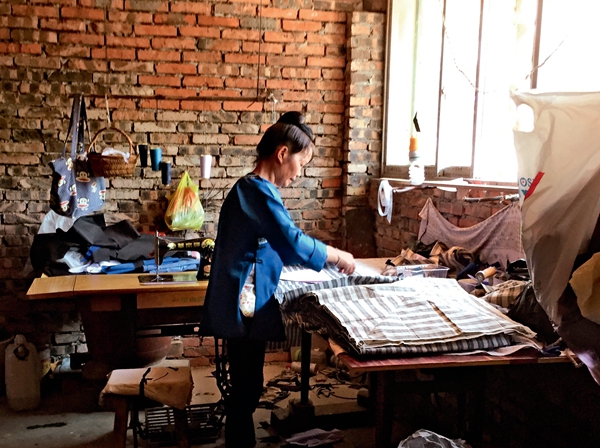By staff reporter ANNA SOWLEY
By staff reporter ANNA SOWLEY
AN Atlas moth hangs framed in suspended animation on the wall of a small design studio hidden down a Beijing alley, its silver-tipped wings gleaming in the afternoon light. The silk produced by this huge moth is said to have contributed to the world’s first architecture: carpets. It’s a good starting point for a company devoted to design, hence the name “Atlas Design.” The founding members of the company have a genuine interest in carpets – a future project is in the pipeline – but they are also intent on creating what they call a “design atlas,” preserving design heritage and amassing a collection of craft techniques to be used in future innovations.
Atlas Design came about when three alumni of Rhode Island College of Design decided to pool their respective skills and start a design company in Beijing. It made sense, explained co-founder Catherine McMahon, because “Beijing is still the cultural capital of China. People who have invested in traditional Chinese design are either in Beijing or Hangzhou.” Catherine formerly worked for a consulting firm in Shanghai dealing with the societal impact of new technology, Jenny Chou contributed to disaster reconstruction by working for renowned architect Hsieh Ying-Chen from Taiwan, and Ahti Westphal did regional planning and park management in Cambodia. “We all have the same core education,” Catherine explained, “but because of our life experience we all have completely different skills.”

The company has three strands weaving towards the realization of their “design atlas.” As trained architects, interior design work and building design is their bread and butter, but their research interests lie more in the field of crafts and cultural heritage. The second strand involves cultural preservation and social enterprise – the desire to help others keep their traditional craft culture alive. The third strand is teaching, which Catherine does by lecturing at the Chinese Academy of Fine Arts (CAFA), and which the studio does collectively by putting together workshops and educational programs showcasing traditional crafts.
Crafting Social Enterprise
The studio has a connection with a group of ethnic minority Dong women from the tiny mountain village of Dali in Guizhou Province, southwest China, who produce handwoven fabrics. When Atlas first visited the place, all the members of the team were stunned by the area’s natural beauty – the greenery, the rich red earth, the sheer magic of the place – and how “spatially dynamic” it was. The surrounding hills must be constantly farmed in order to grow the crops that the village depends on. “There is an intense relationship between humans and nature,” Catherine observed during her visit. “It takes many generations of people contributing to make a place that strong – and to destroy it could be so quick.”
The village was in need of something more than just farming. Guizhou’s government is progressive in terms of eco-development, and invests in cultural preservation – but villages this remote are often the last to see any of the cash. Atlas teamed up with the Global Heritage Fund to create an “evolving social enterprise model” which will benefit women of the village and their families as well as preserving their traditional craftwork. The local government has since turned their attention to Dali, and plans are in the works to increase tourism to the region. But in terms of local enterprise, it is the women who are forging the way.
“There was no organization around the textiles,” Catherine commented on the women’s weaving. “Really not commercial. It’s all personal.” The craftspeople are mostly middle-aged or older women. Their skills won’t be passed down to younger generations because they are not seen as economically advantageous. Traditionally, it was always men who did business – women’s work was not seen as marketable. Atlas helped develop a model whereby the valuable cultural heritage of Dali’s craftwork can be preserved and utilized in a wider context, while earning money for the village and giving women’s work economic value.
This required diversification. “What you have to do to keep something alive is not just one thing; you have to do lots of different things,” Catherine explained. There is a rigid mode of production for these crafts, which are governed by a series of strict cultural rules (men are not even allowed to touch the indigo dye used to color the fabrics), but Atlas saw room for innovation in terms of design and marketing. They teamed up with female entrepreneur Lie Jia to help develop a way of commercializing the craft process.

Lie Jia was one step ahead of the other women in the village in terms of education. She was part of a Dong chorus who travelled around the country competing in singing contests, and her experience gave her a wider lens to focus on her own culture. Using her knowledge, she managed to develop her small weaving enterprise on a commercial scale. She formed a cooperative, encouraging other weavers to gather under the umbrella of her burgeoning brand. She now has over 200 weavers, a new showroom, a large farmhouse with 30 looms, teaching facilities, and accommodation for visiting school groups. She does cooperative projects with fashion labels and sells her fabrics online.
All she needed was a larger market. The fabrics produced by the Dong women are, as Catherine describes them, “insanely labor intensive.” A lot of work, manual labor and time go into each length of cloth. The famous Guizhou glossy cloth is handwoven cotton dyed with indigo and then over-dyed several times with a red berry dye infused with egg white. The indigo process alone takes months. Rain fabric is a beautiful snow-white cloth woven from cotton and then left outside for days in the fields to be naturally bleached by the sun and morning dew. It is a gorgeous, extremely high-quality fabric. Something this labor intensive deserves a price to match.
Guizhou Voices on the World Stage
The longer Atlas worked with these extraordinary women, the more obvious it became that they should be sharing their experience with a wider audience – and that meant bringing the Dong women and their skills to the cultural capital. The women had a great time in the city, experiencing so many new things and thoroughly enjoying themselves – they had never even seen trains or buses before – and the art world in Beijing learned a lot from their example. “It really matters what people get exposed to,” Catherine explained, “not for them, for us!”
As part of Beijing Design Week 2016, Atlas held a series of workshops and also participated in a symposium “Thinking by Hand,” which promoted discussion in the design world that included “indigenous voices and traditional land-based ideas” – voices not usually heard in these academic conversations. It was also a way of exposing people to new ways of thinking and encouraging a dialogue between communities. “To know there is some kind of reciprocity between our learning and their learning – it’s a powerful trade... Design gives us a means to interact with communities we wouldn’t normally be able to talk to… Hosting a conference with people on the frontlines of nature claiming the space in the design conversation was very meaningful, I think.”

The conference was useful academically, but Atlas also wanted to hold a workshop to allow people to physically experience these traditional crafts. They created an “Indigo Room” as part of Beijing Design Week, to show just how intricate the dye process is. They were gifted a “mother dye” by Lie Jia, which was an honor for the studio. “It’s like a state secret for these women,” said Catherine. “It’s their technology. So the fact that we had one in Beijing was unheard of. It was a beautiful thing.”
The room was a kaleidoscope of blue. Samples displayed around the walls showed different shades resulting from dye attempts made during each of the 24 solar spells. Indigo is so delicate and temperamental that it can only be used effectively in one specific season – the chemistry of the dye changes with the weather. It’s a mystical process, one that transmitted its wonder and mystery to all who entered the room. “The room smelt of indigo,” Catherine remembered, with a smile. “I can’t think of anything more beautiful.”
Using the indigo designs and fabrics developed in collaboration with Atlas, the Dong ladies were encouraged to develop a series of their own products. One made a collection of bags, which she brought with her to Beijing. This is a two-way exchange: the Dong ladies provide the skills and traditional production methods; and Atlas supplies the product design, quality control, and business plan. They are currently in talks to take a range of products, including chairs and cushions, to New York as part of an “elevated design series” geared towards the high-end market. A number of other international cooperative social enterprises have successfully used this model, notably Norlha Textiles, a Tibetan project which restored an entire village using the proceeds from its luxury yak-wool weaving business. Atlas hopes to achieve similar results for Dali over the next year.
Value in Nature
Meanwhile the learning process continues – after all, Atlas is dedicated to research. They are already experimenting with new ways to use indigo and rain fabric in future product design. They are also constantly adding to their “design atlas” by learning new skills. After failing to achieve quite the right look for a paper lamp, the team decided to make their own paper from scratch, learning the technique from a family of master papermakers from Anhui Province. “It’s not like we’re against industry where it can benefit us,” Catherine smiled, “but we would like to get down to the natural materials where we can.”
One of the benefits of trial and error in design is the realization that technique is central – learning how to make these materials gives designers a greater understanding of the whole process, and ultimately aids creativity in innovation.
The future is bright for Chinese crafts. With more enterprises on board with the idea of sustainable development, traditional crafts can be preserved for future generations, while economically benefiting people like Lie Jia who are working hard to keep these traditions alive. This process also helps local craftspeople to take greater pride in their work – to know that its value extends far beyond their small rural communities. For women in these communities, this is especially important, as it opens opportunities from which they have always been traditionally excluded.
“We wanted them to understand how much their culture is valued by other people,” Catherine said. “It took a long time to build a relationship of trust… but either women can be cut out of that, or they can lead it.” Women like Lie Jia have stepped up and shown that they are more than ready to lead this rural economic revolution.